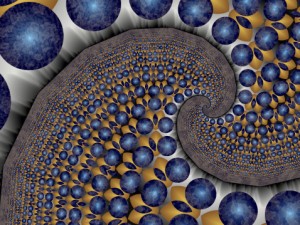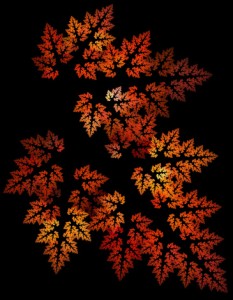Folds, Fractals and Holograms in Lurianic Kabbalah (Part 5)
By Asher Crispe: June 21, 2012: Category Inspirations, Networks of Meaning
Fractals
 New frontiers are always waiting. They wait at times right beneath our nose. Ordinary objects that we’ve traced countless times according to the contours of their large scale shape camouflage a whole series of hidden worlds in their unexplored crevices that express the irregularity of the self-similar object that slid under the measuring rod. Smaller scale measurements reveal a more complex body. The larger structure cedes to a more delicate and suppressed architectonic.
New frontiers are always waiting. They wait at times right beneath our nose. Ordinary objects that we’ve traced countless times according to the contours of their large scale shape camouflage a whole series of hidden worlds in their unexplored crevices that express the irregularity of the self-similar object that slid under the measuring rod. Smaller scale measurements reveal a more complex body. The larger structure cedes to a more delicate and suppressed architectonic.
We can zoom in again and again, and each new push deeper and deeper into the details extends our measure and rejects our initial estimates. Of the sefirot, we can say the same thing. On the large scale they feign independence. Each property rests at home in its definition. Push inwardly however, and the boarders become fuzzy. Everything is everywhere.
The reductionism of the Chain of Being, the elements, with their “ontological discontinuity” unfolds or breaks up into a multitude of the multiple–or as Maurice Blanchot would say “the multiple of the multiple”–until paradoxically there would only be one. Is the plural of pluralism drawn out without end taken back to the One?
Despite the success of Leibniz with his monads and all the pleats and folds in reality reflecting and inflecting the whole in the part, there are a number of new theories that can share his spotlight. Fractals are one such theory.
A simple comparison of 10 times 10 (and so on to infinity), if it is to have any meaning (even if it only be an abstract one) in the science of sefirot, must observe several of the key definitions of fractals. For starters there is the notion that, in the words of James Gleick: “Self-similarity is symmetry across scale. It implies recursion, pattern inside of pattern.” (29) This is precisely the underlying notion at work in Kabbalah in general and Lurianic Kabbalah in particular.
Noting that Kabbalah is sometimes referred to as chen which loosely translated as “grace” and might be better served by rendering it as “symmetry” (an idea alluded to in countless kabbalistic texts), we find that Kabbalah in general seeks “symmetry across scale” or a system of correspondences. Tackling the complexity of the Lurianic presentation of the same material finds comfort in the super-symmetry that comes with working regularly in a higher number of dimensions.
Digging into the “patterns within patterns” such as four worlds within four worlds, we experience another subtle element of fractals, that is, according to Roger Penrose: “We find an endless variety: no two regions are precisely alike—yet there is a general flavor that we soon become accustomed to.”(30) These regional nuances form from the fusion of forces that creates them.
If we imagine three friends with three separate homes that they live in, each “combination” for friends will be slightly varied depending on whose house they decide to get together in. The host paints the program, while the other two, being guests in a home not there own, are likely to modify their behavior i.e. not feel as free to kick back and relax as if it were their own home. The group dynamics shifts depending on the context.
 Consequently, while there may be chochmah (wisdom) within malchut (kingdom/self-expression) and malchut with chochmah, these cannot be considered identical although they may bear a certain limited resemblance. So too with yesod (foundation/self-actualization) within malchut within chochmah–the stacking of interrelationships theoretically avoids redundancy and allows for endless variety.
Consequently, while there may be chochmah (wisdom) within malchut (kingdom/self-expression) and malchut with chochmah, these cannot be considered identical although they may bear a certain limited resemblance. So too with yesod (foundation/self-actualization) within malchut within chochmah–the stacking of interrelationships theoretically avoids redundancy and allows for endless variety.
Speaking of vast networks of interrelated ideas, the domain names on the Internet exemplify the ability to navigate and differentiate between varieties of available content and information while preserving a sense of everything being everywhere via hyperlinks. The electrical circuitry of a text like Etz Chaim, crystallizes into a garden of amazing conceptual shapes if we allow ourselves to plunge into the world of fractals. On the net, the build up of our definition of fractals continues as we see on Wikipedia under “Fractal”:
In colloquial usage, a fractal is a shape that is recursively constructed or self-similar, that is, a shape that appears similar at all scales of magnification and is therefore often referred to as “infinitely complex.”
The “on and on” interinclusion extended indefinitely (if not infinity), displays the magic of the “infinity complex” fractal. Moreover, on Fractalus.com we read about:
…a shape that when you look at a small part of it, has a similar (but not necessarily identical) appearance to the full shape….teasing with a bit of familiarity and tantalizing with new and unexpected twists….With just a single fractal shape, you can explore forever and never see everything it has to offer. The further you zoom, the more likely you are seeing something that no one has seen before.
Spreading out over as many pockets of experience as possible permits the Lurianic project to “see something that no one has seen before.” Each new window opened up in the zooming in process expands rather than shrinks our horizon.
(29) Chaos. P.103.
(30) The Emperor’s New Mind. P.79.
http://www.interinclusion.org/inspirations/folds-fractals-and-holograms-in-lurianic-kabbalah-part-6/























;)
;)
;)
;)
;)
;)
;)
;)
;)
;)
